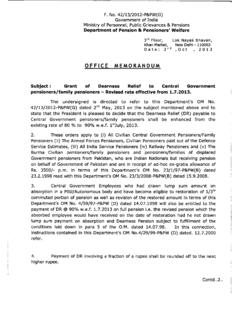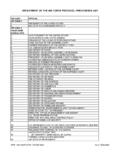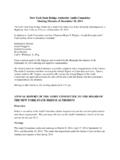Transcription of Consolidated Audit Guide for Audits of HUD …
1 Consolidated Audit Guide for Audits of HUD Programs Handbook ( ) office of the Inspector general 2016 REV-2 CHG-20 Paragraph Page Table of Contents 1. general Audit GUIDANCE 1-1 2. REPORTING REQUIREMENTS AND SAMPLE REPORTS 2-1 3. HUD MULTIFAMILY HOUSING PROGRAMS 3-1 4. MORTGAGE INSURANCE FOR HOSPITALS PROGRAM 4-1 5. INSURED DEVELOPMENT COST CERTIFICATION Audit GUIDANCE 5-1 6. GINNIE MAE ISSUERS OF MORTGAGED-BACXED SECURITIES Audit GUIDANCE 6-1 7. FHA-APPROVED LENDERS Audit GUIDANCE 7-1 APPENDIX i 12/01 REV-2 CHG-17 5/2013 1-1 CHAPTER 1. general Audit GUIDANCE 1- 1. Purpose. This Audit Guide is to assist the independent auditor (auditor) in performing Audits of profit-motivated entities that are subject to the Department of Housing and Urban Development s (HUD) uniform financial reporting standards set forth in 24 CFR (Code of Federal Regulations) Part 5, Subpart H; and 24 CFR Part (g) and related mortgagee letters.
2 HUD requires an Audit that consists of two components: a financial statement Audit of the entity and a compliance Audit of the entity s major HUD programs. The Audit must be performed in accordance with generally accepted auditing standards (GAAS), issued by the American Institute of Certified Public Accountants (AICPA), and generally accepted government auditing standards (GAGAS), issued by the Comptroller general of the United States. For Securities and Exchange Commission registrants, the financial statement Audit may be performed in accordance with the standards of the Public Company Accounting Oversight Board (PCAOB) and GAGAS. Additionally, the compliance Audit is to be conducted in accordance with this Audit Guide , which requires that the auditor perform procedures that enable the auditor to opine on whether the entity has complied with laws, regulations, and the provisions of contracts or grant agreements applicable to its major HUD programs.
3 The use of this Audit Guide is mandatory for Audits of all for-profit participants; however, this Audit Guide is not intended to be a complete manual of Audit procedures for the compliance Audit . The Audit Guide is not intended to cover all situations that may exist or replace the auditor s judgment of Audit work required to meet GAAS and GAGAS. It is meant to supplement those standards with information specific to HUD programs. Suggested Audit procedures contained herein might not cover all circumstances or conditions encountered in a particular Audit . The auditor should use professional judgment to tailor the procedures so that the Audit objectives are met.
4 However, auditors must address all compliance requirements in this Audit Guide that could have a direct and material effect on a major HUD-assisted program. If the auditor determines that certain procedures for a compliance requirement will not to be performed, the rationale for the exclusion must be explained and documented in the Audit documentation in support of the auditor s report. An example would be a situation in which circumstances pertaining to the auditee are such that the auditee is not subject to a particular requirement. This Audit Guide is divided into chapters. This chapter, c hapter 1, documents the purpose, background, and requirements for performing a HUD-required Audit .
5 It also includes other matters the auditor should consider in preparing for the Audit . Chapter 2 contains the reporting requirements. Both chapters 1 and 2 apply to all Audits covered by this Audit Guide . Each of the remaining chapters contains procedures for auditing compliance with specific HUD program requirements. Chapters 3 through the remainder of the Guide contain references to releva nt compliance requirements that were in effect at the time each chapter was issued. Auditors should recognize that compliance requirements change periodically and that delays will occur between such changes and revisions to this Audit Guide .
6 Moreover, auditors should REV-2 CHG-17 5/2013 1-2 recognize that there may be provisions of contracts and grant agreements that are not specified in law, regulation, or other HUD requirements contained in HUD handbooks, notices, and mortgagee letters; therefore, the specifics of such are not included in this Audit Guide . Accordingly, the auditor should perform reasonable procedures to ensure that compliance requirements are current and to determine whether there are any additional provisions of contracts and grant agreements that should be covered by an Audit under this Audit Guide . Reasonable procedures would be inquiry of auditee management and review of the contracts and grant agreements for major programs.
7 HUD documents are available in the HUD Client Information and Policy System (HUDCLIPS), at the following Internet address: If the auditor desires technical assistance pertaining to HUD programs, regulations, or operations, the auditor should contact the particular HUD headquarters or field program offices listed in the applicable chapter or contact the office responsible for monitoring or overseeing the activities of the auditee. 1- 2. Use of This Audit Guide for Audits of States, Local Governments, and Nonprofit Organizations. Governmental and nonprofit entities also participate in some of the HUD programs covered in chapters 3 through 7 of this Audit Guide .
8 These entities are subject to the Audit requirements in office of Management and Budget (OMB) Circular A-133, and auditors should normally use OMB s Compliance Supplement to perform the Audit and not this Audit Guide . However, in instances in which a program is not included in the OMB Compliance Supplement but is covered in this Audit Guide , the auditor should use the compliance requirements and suggested Audit procedures in this Audit Guide for purposes of building an Audit program using the guidance in part 7 of the OMB Compliance Supplement. 1- 3. Audit Scope and Approach. A. Financial Statement Audit . The financial statement Audit should be planned to be sufficiently comprehensive in scope to permit an expression of an opinion on the financial statements and an in-relation-to opinion on the supplementary information of the HUD-assisted activity as referenced in the relevant chapters in this Audit Guide .
9 GAAS requires that a sufficient understanding of internal controls be obtained to plan the Audit and to determine the nature, timing, and extent of tests to be performed. In fulfilling the Audit requirement relating to an understanding of internal controls and assessing the level of control risk, the auditor should follow, at a minimum, the guidance contained in the AICPA s Codification of Statements on Auditing Standards (AU-C) Section 315, Understanding the Entity and Its Environment and Assessing REV-2 CHG-17 5/2013 1-3 the Risks of Material Misstatement. GAGAS provides an additional requirement for reporting on internal control over financial reporting (see chapter 2 of this Audit Guide ).
10 B. Compliance Audit . This Audit Guide requires an opinion on the auditee s compliance with specific requirements applicable to each major program included in the Audit . The auditor should use the following information to determine whether a program is considered to be a major program for the type of Audit being performed using a specific Audit Guide chapter. Chapters 3 and 4: A major program is defined as an individual assistance program for which expenditures equaled or exceeded $500,000 during the applicable year or a project or hospital that had an outstanding HUD-insured or HUD-guaranteed loan balance equal to or exceeding $500,000 as of the end of the period under Audit .
















